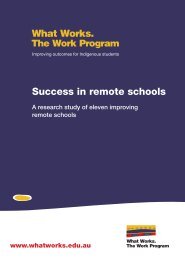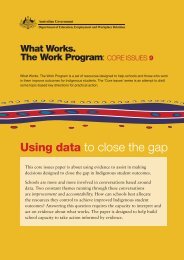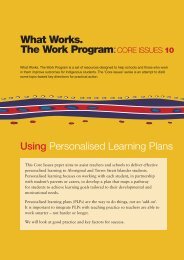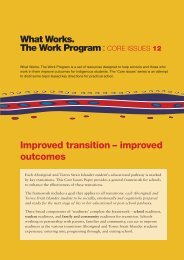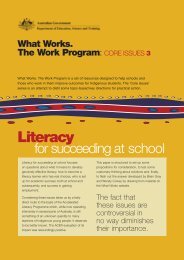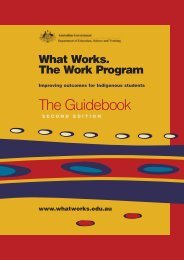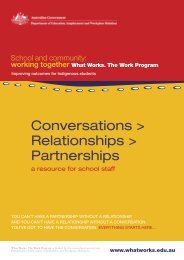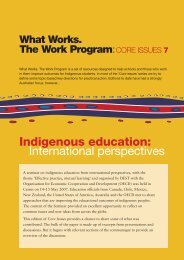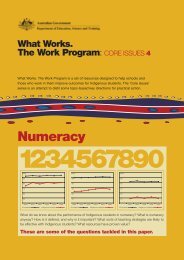MATHEMATICSMeasurementConcept In Year 1the student:In Year 2the student:In Year 3the student:In Year 4the student:In Year 5the student:In Year 6the student:In Year 7the student:In Year 8the student:In Year 9the student:Attributes(length, mass,area, volume,mass) <strong>and</strong>choosing <strong>and</strong>using units tomeasure themDifferent units areneeded to measuredifferent attributes.Deciding what needsto be measured in asituation <strong>and</strong> choosingthe most appropriateunit <strong>and</strong> tool to carryit out to the neededdegree of accuracy.• Underst<strong>and</strong>s the concept oflength <strong>and</strong> respondscorrectly to “findsomething ‘longer’ or‘taller’ or ‘wider’”• Decides which attribute ashape or object mainlydisplays (e.g. knows that apiece of string has length<strong>and</strong> a stone has mass)• Knows that you talk aboutkilograms when lifting <strong>and</strong>weighing things• Knows that you talk aboutlitres when you talk abouthow much liquid• Knows that length <strong>and</strong>width <strong>and</strong> height are aboutdistance between twopoints• Identifies <strong>and</strong> distinguishesthe attributes of shapes <strong>and</strong>objects with respect tolength, area, volume <strong>and</strong>mass (e.g. selects the mostappropriate attributes todescribe a shape or object;knows that the ‘amount ofheaviness’ is about ‘mass’)• Knows roughly what akilogram <strong>and</strong> litre are inthe context of familiaritems (e.g. identifies akilogram packet of sugar<strong>and</strong> a litre carton of milk)• Uses appropriate languageto describe length, width<strong>and</strong> height <strong>and</strong> the distancebetween two points <strong>and</strong>measures these usingin<strong>for</strong>mal units such asstraws, string <strong>and</strong> paces<strong>and</strong> <strong>for</strong>mal units includingcentimetres <strong>and</strong> metres• Identifies <strong>and</strong> comparesthe attributes of shapes <strong>and</strong>objects with respect tolength, area, volume <strong>and</strong>mass (e.g. knows that asuitcase has height, width,length, capacity <strong>and</strong> mass<strong>and</strong> describes thedifference, saying “themass is how much itweighs when it is empty<strong>and</strong> the capacity is howmuch it will hold”)• Knows of related historicalunits of length includinginches to centimetres, feet<strong>and</strong> yards to metres• Measures lengths ofstraight <strong>and</strong> curved edgesusing simple straight edges(such as rulers) <strong>and</strong> payingattention to the exact start<strong>and</strong> end of the length beingmeasured (to ensure theyare measuring <strong>and</strong> not justcounting units)• Uses measuringinstruments includingrulers, tape-measures, litrejugs<strong>and</strong> area grids• Chooses the appropriateattribute when comparingobjects or solving practicalproblems (e.g. decideswhich suitcase is the‘biggest’ in order to packmore clothes, knows it isthe capacity that isimportant not the height orwidth of the suitcase)• Knows that the larger theunit chosen, the fewerrequired to measure (e.g. ifthey use a piece of A3paper to measure the areaof the table top there willbe less needed than if theyuse a piece of A4 paper tomeasure it with, <strong>and</strong> usinga metre ruler to measurethe length of the ver<strong>and</strong>ahwill give a smaller amountthan using a 30 cm ruler• Measures <strong>and</strong> comparesdifferent lengths using anappropriate instrument byfirst identifying theprecision required <strong>for</strong> thecontext (e.g. to decidewhether a table will fitthrough a doorwaychooses a centimetre tapemeasure<strong>and</strong> measures tothe nearest centimetre)• Underst<strong>and</strong>s that toadequately compare <strong>and</strong>describe something, two ormore attributes are betterthan one (e.g. whencomparing two people’sbuilds, heights, <strong>and</strong> massesprovides more in<strong>for</strong>mationthan just height)• Uses commonsense in thechoice of units of length<strong>for</strong> familiar practicalmeasurement tasks (e.g.uses ‘h<strong>and</strong> spans’ <strong>for</strong> thefirst rough measure ofwhether a bookcase will fitthrough a doorway)• Chooses <strong>and</strong> uses anappropriate unit <strong>and</strong>instrument (or othertechnology) to measure arequired attribute orcharacteristic (e.g. choosesa tape measure orblackboard ruler tomeasure heights ofstudents in the class <strong>and</strong>knows that this willprovide measurements thatare ‘accurate enough’ <strong>for</strong>filling in a personal <strong>for</strong>m);Is familiar with SI units ofmeasurement <strong>and</strong> c<strong>and</strong>istinguish them from‘older units’ such as tons,inches, pints, <strong>and</strong> pinch,smidgen <strong>and</strong> tad• Chooses <strong>and</strong> uses variousunits of length as beingmore suitable <strong>for</strong> variouscontexts, <strong>and</strong> measuringtools as giving greateraccuracy (e.g. a trundlewheel <strong>for</strong> measuring thedistance of a 400 metrerunning track or a rulerwith millimetre gradationsto measure the length of aneedle)• Selects units that aresensible <strong>for</strong> the purpose <strong>for</strong>everyday descriptions <strong>and</strong>comparisons (e.g.compares two boxes bycapacity if they want tostore tennis balls but bylength if they want to packbooks)• Knows of related historicalunits of area includinghectares to acres <strong>and</strong>perches• Uses a variety ofinstruments <strong>and</strong>technologies <strong>for</strong> indirectmeasures of quantities(e.g. stopwatch to measureelapsed time, data-loggerto measure temperaturechange)• Chooses <strong>and</strong> uses in<strong>for</strong>mal(e.g., pinch, span), metricor SI (Internationalsystem) units (metres,minutes) to measure withto suit the context (e.g.knows that their h<strong>and</strong>spanwill be good enough as aguide to see whether awardrobe will fit into aspace on the wall in thenext room but if they arepurchasing a wardrobe thatwill fit they will need to bemore accurate <strong>and</strong> measurewith a metric ruler be<strong>for</strong>ethey leave home); Knowswhen measuring whenmore than one attribute isneeded (e.g. knows tomeasure height <strong>and</strong> widthwhen placing a bookcaseunder a window in ahallway)• Chooses <strong>and</strong> uses a varietyof instruments <strong>for</strong> indirectmeasures of quantities (e.g.a stopwatch to measureelapsed time, data-loggerto measure temperaturechange) <strong>and</strong> justifies theirchoice based on the levelof precision needed (e.g.chooses a normal watch tomeasure time taken in abackyard race but explainsthat a stopwatch is neededto measure time taken in arace at the school sports)• Distinguishes between flat<strong>and</strong> curved surfaces• Decides which uni<strong>for</strong>munits (e.g. a piece of paperor square tile used again<strong>and</strong> again) could best beused to measure flatsurfaces <strong>and</strong> talks aboutthem in terms of ‘gaps’<strong>and</strong> ‘overlaps’ (e.g. says“this table top can becovered with this piece ofpaper over <strong>and</strong> over butthe last ones hang over theedge”)• Underst<strong>and</strong>s area is aboutcoverage of a surface <strong>and</strong>measures the area of flatregions using pieces ofpaper, <strong>and</strong> curved regionssuch as a ball, using, <strong>for</strong>example, curved h<strong>and</strong>s• Visualises the size of asquare metre <strong>and</strong> can‘show’ it using their arms• Measures areas of surfacesusing materials provided(such as gridtransparencies <strong>and</strong> piecesof A4 paper), payingattention to gaps <strong>and</strong>overlaps (i.e. knows thegaps <strong>and</strong> overlaps areimportant <strong>and</strong> doesn’tignore them)• Measures <strong>and</strong> comparesdifferent areas or surfacesusing a range of units suchas grids made of squareunits, A4 sheets of paper,square centimetres <strong>and</strong>square metres (e.g. todetermine which book hasthe biggest cover uses A4sheets of paper but usessheets of newspaper todetermine which floor hasthe biggest floor space)• Underst<strong>and</strong>s that a unit ofarea can be cut <strong>and</strong>rearranged <strong>and</strong> still be thesame ‘unit’ (i.e. knows thata ‘square metre’ is a size<strong>and</strong> doesn’t have to be a‘square’; a circle or atriangle can have an areaof a square metre)• Specifies area in terms ofunits 2 by first visualisingthe shape <strong>and</strong> estimatingits area based on theknown size of a squarecentimetre or squaremetre; Calculates thesurface area of shapes <strong>and</strong>objects such as cubes <strong>and</strong>rectangular <strong>and</strong> triangularprisms <strong>and</strong> makes ajudgment about thereasonableness of theresult based on estimation• Knows the relationshipbetween length, width <strong>and</strong>area of a rectangle (e.g.says “two rectangle canhave the same perimeterbut different areas” )• Distinguishes the need tofind area rather thanperimeter (<strong>and</strong> vice-versa)in problem-solvingsituations (e.g. knows theyneed to find perimeter tocalculate fencing costs <strong>for</strong>a property but area tocalculate amount of seedneeded)• Suitably dissects acomposite shape intoseveral rectangles (<strong>and</strong>other shapes as needed) inorder to find the area of theshape choosing <strong>and</strong> usingappropriate <strong>for</strong>mulae• Correctly decides which oftwo containers containsmore or less,demonstratingunderst<strong>and</strong>ing of these twoideas• Explains <strong>and</strong> shows why aparticular container holdsmore than another one <strong>and</strong>is not confused by whichone ‘looks bigger’ (e.g.fills two containers using athird container to• Measures how much acontainer holds <strong>and</strong>compares <strong>and</strong> orders up tothree containers accordingto their volume (amountthey hold when full) usingliquid• Measures volumes ofliquids using simplemeasuring instrumentsprovided (such as jugswith 100 ml gradations)being careful to ensure thereading is ‘exact’• Measures <strong>and</strong> comparesvolumes of liquids by firstchoosing appropriateinstruments <strong>and</strong> units <strong>and</strong>reading scales as needed(e.g. choosing an eyedropperor teaspoon to• Measures the volume ofprisms made up of cubesby counting the number ofcubes in one layer of theprism <strong>and</strong> multiplying bythe number of layers• Specifies volume in termsof units 3 by firstvisualising the container orspace <strong>and</strong> estimating itsvolume based on theknown size of a cubiccentimetre or a litre;• Explores the volume ofpyramids <strong>and</strong> cones <strong>and</strong>their relationship with thevolume of the prism thatwould exactly encompassthem; calculates thevolume of a sphere <strong>and</strong>• Suitably dissectscomposite shapes intoseveral rectangular prisms(<strong>and</strong> other 3D shapes asneeded) to determinevolume of the shapechoosing <strong>and</strong> using<strong>Bound</strong> <strong>for</strong> <strong>Success</strong> <strong>Scope</strong> <strong>and</strong> <strong>Sequence</strong> <strong>Statements</strong> V2 Page 35 Working Document Semester One 2007
MATHEMATICSMeasurementConcept In Year 1the student:In Year 2the student:In Year 3the student:In Year 4the student:In Year 5the student:In Year 6the student:In Year 7the student:In Year 8the student:In Year 9the student:demonstrate that one measure 10 ml of medicine Calculates the volume of explores its relationship appropriate <strong>for</strong>mulaecontainer holds more)• Measures how much a boxholds <strong>and</strong> compares <strong>and</strong>orders up to three boxesaccording to their volume(amount they hold whenfull)<strong>and</strong> graduated measuringjug to measure 150 ml)cubes, rectangular <strong>and</strong>triangular prisms (usingbase x perpendicularheight) <strong>and</strong> makes ajudgment about thereasonableness of theresultwith the volume of thecube that would exactlyencompass it• Hefts two objects (lifts <strong>and</strong>holds them) <strong>and</strong> correctlysays which is heavier orlighter• Arranges 3 objects interms of mass <strong>and</strong> is notconfused by which looksheavier or lighter• Uses words such as ‘light’<strong>and</strong> ‘heavy’ to describe<strong>and</strong> compare mass by firsthefting (e.g. says “thisbook is really light <strong>and</strong>this one is heavy so thelight one has more mass”)• Measures masses ofdifferent objects usingsimple measuringinstruments provided (suchas bathroom scales, withkg gradations) beingcareful to ensure theirreadings are ‘exact’• Measures <strong>and</strong> comparesmasses of different objectsby first choosingappropriate instruments<strong>and</strong> reading scales asneeded (e.g. chooseskitchen scales to measure500 grams of flour <strong>and</strong>bathroom scales to weighthemselves <strong>and</strong> a friend tothe nearest kg)• Adds length <strong>and</strong> massmeasurements in order tocalculate total size (e.g. tomake up 1 kg of bananaswith a scale that only goesto 500g, weighs a fewbananas at a time <strong>and</strong> addstheir weights)• Knows the relationshipbetween the length, widthheight, <strong>and</strong> volume of aright (angled) prism (e.g.says “the length <strong>and</strong> widthtell us what the area of thebase or first layer is <strong>and</strong>then the height tells us howmany layers there are sowe can work out thevolume: the greater theheight the greater thevolume”)• By measuring accuratelydetermines when anestimate or a measurementhas been made (e.g.determines whether theweight of a personindicated is really 150 kgor 154 kg by weighingusing an accurate scalewith gradations marked at150, 151, 152 …160rather than just 150 <strong>and</strong>160)• Reads scales <strong>and</strong> makesreasonable estimates wheremeasures fall betweenmarked graduations (i.e.intermediate graduationsnot marked); Identifies theinterval within which ameasurement occurs (e.g.the speedometer of a cartypically provides a valuewhich is accurate to plus orminus 3 km per hour)• Knows comparablemeasurement languageincluding bigger, smaller,taller, tallest, heavy,heaviest, longest, shorter,same length, near, far• Makes direct comparisonsof two objects (compareswith each other) <strong>for</strong> length,width, height, width <strong>and</strong>mass• Makes direct comparisonsbetween objects <strong>for</strong> agiven attribute (e.g.arranges people in order ofheight or hefts 3 or moreobjects <strong>and</strong> puts them inorder of mass)• Compares the length oftwo objects not in the sameroom using a ‘go-between’(i.e. a third object) (e.g.uses a piece of string tocompare the width of a bedin one room with a bed inanother room)• Arranges recordedmeasurements inincreasing or decreasingorder of magnitude by firstidentifying different <strong>for</strong>msof recording these (e.g. 1½kg, 1700 g, 175 kg, 200g)• Knows equivalent <strong>for</strong>ms ofst<strong>and</strong>ard units (e.g. 1.5 kg= 1 500 g, <strong>and</strong> 600 ml =0.6 L)• Knows how many of onesize unit there are in thenext size unit (bigger <strong>and</strong>smaller) (e.g. knows thereare 1000 mg in a g <strong>and</strong>1000 g in a kg)• Reads <strong>and</strong> recordsmeasurements fromcalibrated scales in whichintermediate gradations arenot numbered (e.g. amedicine glass, aspeedometer)• Converts from one sizeunit to the next size unit(e.g. m to cm, cm to mmetc) <strong>and</strong> can roundupwards or downwards tothe next unit depending onthe degree of accuracyrequired in context (e.g.converts 3 200 ml to 3.2 L<strong>and</strong> says “that 3 litre jugwon’t hold this liquidbecause there’s too muchof it”)• Converts between differentunits of measure <strong>for</strong> thesame attribute (e.g.expresses 4.5 ha in squaremetres, converts 35.67tonnes to kilograms,calculates the number ofseconds in 3 hours <strong>and</strong> 25minutes, finds the metricequivalent in mm of a 1/8inch drill bit)• Chooses things that have‘length’ as an obviousattribute (e.g. pencil, stick)• Chooses <strong>and</strong> uses thingsthat relate well to length touse as units <strong>for</strong> measuring(e.g. chooses <strong>and</strong> uses apiece of string <strong>for</strong>‘measuring’ length)• Chooses <strong>and</strong> uses theappropriate metric unit tomeasure different lengths<strong>and</strong> different masses (e.g.cm <strong>and</strong> m <strong>for</strong> length <strong>and</strong> g<strong>and</strong> kg <strong>for</strong> mass)• Chooses <strong>and</strong> uses theappropriate metric unit tomeasure different lengths<strong>and</strong> different masses (e.g.chooses <strong>and</strong> used cm <strong>for</strong>measuring length of a desk<strong>and</strong> m <strong>for</strong> measuring thelength of the room)• Underst<strong>and</strong>s the concept of‘accuracy’ <strong>and</strong> knows thatsome measurements needto be more precise thanothers because of thecontext <strong>and</strong> purpose <strong>for</strong>measuring (e.g. knows thataccuracy is needed whenmeasuring quantities tomake a cake but whencooking potatoes ‘one <strong>for</strong>each person’ is accurateenough)• Chooses an appropriateunit <strong>and</strong> instrument orother technology tomeasure a requiredattribute or characteristic(e.g. chooses a tapemeasure or blackboardruler to measure height ofstudents in the class <strong>and</strong>knows that this willprovide measurements thatare ‘accurate enough’ <strong>for</strong>filling in a personal <strong>for</strong>m)• Can identify relationshipsbetween metric units (e.g.2.75 KL = 2750 L) <strong>and</strong> canconvert from one size unitto the next size unit (e.g. mto cm; converts 3.4 m to340 cm <strong>and</strong> vice versa, cmto mm; 4.1 cm to 41 mm<strong>and</strong> vice versa)• Chooses <strong>and</strong> effectivelyuses an appropriate unit<strong>and</strong> instrument ortechnology to measure arequired attribute orcharacteristic <strong>and</strong> justifiestheir choice in the context(e.g. says “I need somekitchen scales becausebathroom scales are notaccurate enough tomeasure recipe ingredientswith”)• Uses everyday measuringinstruments correctly <strong>and</strong>accurately in order tominimise error <strong>for</strong> a givencontext (e.g. places ameasuring jug on a flatsurface <strong>and</strong> readsgradations at eye-level tomeasure as accurately aspossible)• Makes non-numericalestimates of size usingmovements <strong>and</strong> actions(e.g. uses h<strong>and</strong>s/armswhen describing ‘howbig’)• Estimates length usingbody parts such as fingers,spans, feet <strong>and</strong> otherpersonal referents (e.g.says “the pencil is about 3fingers long” <strong>and</strong> “thedoor is about the sameheight as I am”)• Estimates whethercontainers hold more, lessor the same as a litre (e.g.says “the jug holds a bitmore than a litre”);expresses theirmeasurements using‘between’ using everydayobjects as their reference(e.g. says “the doorway isbetween 5 <strong>and</strong> 6 bookswide”)• Estimates lengths <strong>and</strong>masses by makingcomparisons (e.g. says “Ithink it weights about 4 kgbecause it’s about twice asheavy as this bottle whichweighs 2 kg” <strong>and</strong> “it’sabout 2 metres highbecause I’m one metretall”)• Uses known measures offamiliar objects to makereasonable estimates oflength, area, mass <strong>and</strong>volume (e.g. volume of adrink can, mass of amargarine container, ownheight, area of piece of A4paper; uses language suchas ‘between’ to describemetric estimates (e.g. says“the book weighs between1 kg <strong>and</strong> 2 kg” using aone-kg bag of sugar astheir reference)• Recognises when anestimate is sufficient <strong>and</strong>when they need to measure(e.g. to order a newbookcase over the phonethey need to measurerather than describe bysaying ‘it’s about 1 metrewide”)• Identifies unreasonableestimates of measurementsbased on their ability to‘see’ the unit in theirmind’s eye (e.g. says“there is no way ourbackyard is 2 hectares”)• Identifies unreasonableestimates of measurementsby comparing with aknown measurement (e.g.says “that room can’t be 8metres long since my strideis less that a metre <strong>and</strong> theroom is only 7 strideslong”)• Estimates length, area,volume, mass, time of day<strong>and</strong> duration of time, angle<strong>and</strong> temperature bycomparison withexperience <strong>and</strong> withrespect to knownreferences (e.g. estimatesthe time of day byreferring to the position ofthe sun); Makes judgmentsabout acceptable variationin estimation of quantitiesbased on experience (e.g.wants 250 g of olives froma deli, but will accept aquantity within the range<strong>Bound</strong> <strong>for</strong> <strong>Success</strong> <strong>Scope</strong> <strong>and</strong> <strong>Sequence</strong> <strong>Statements</strong> V2 Page 36 Working Document Semester One 2007



